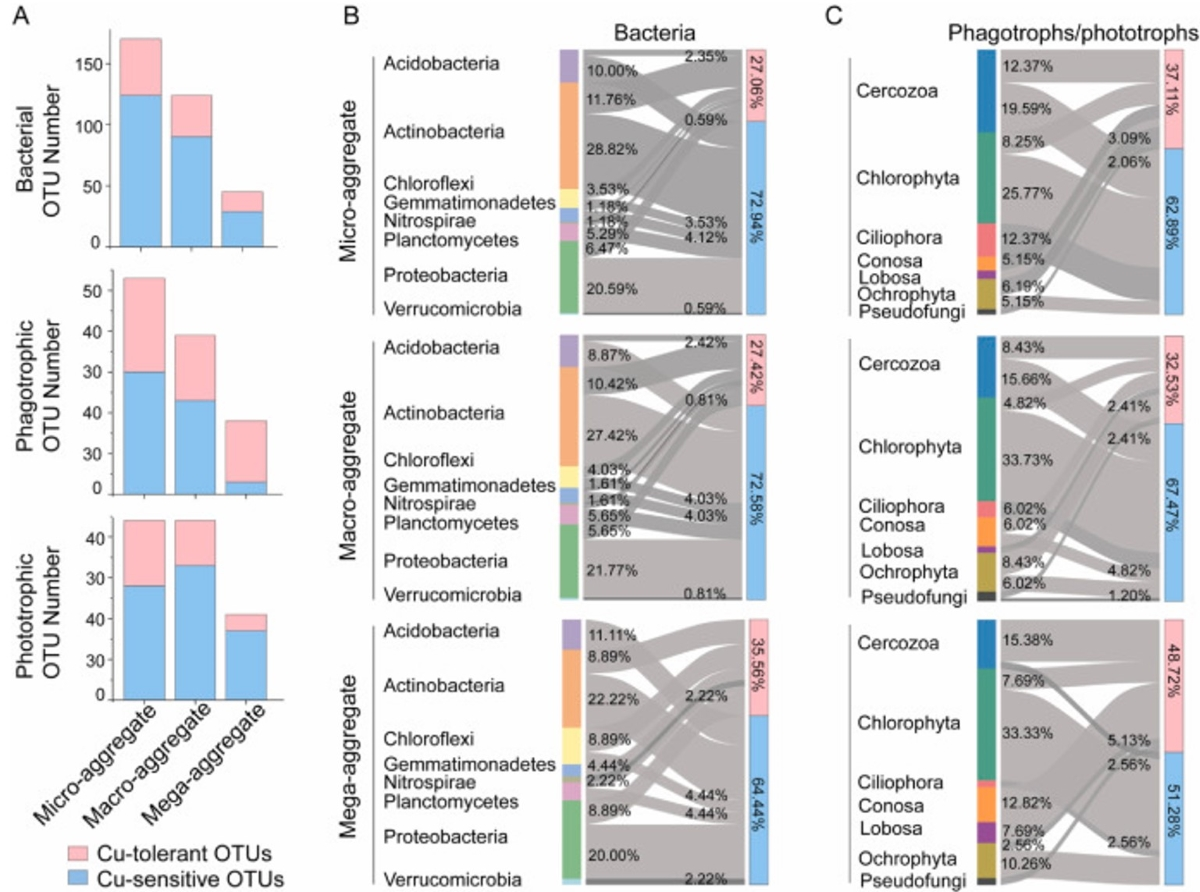核心提示: 近日,我校农业微生物资源发掘与利用全国重点实验室、资源与环境学院土壤生物化学与环境课题组黄巧云团队在土壤团聚体原生动物分布及调控耐铜细菌群落方面取得系列进展,相关研究成果分别发表在Environmental Science & Technology和Soil Biology and Biochemistry上。
南湖新闻网讯(通讯员 吕振光)近日,我校农业微生物资源发掘与利用全国重点实验室、资源与环境学院土壤生物化学与环境课题组黄巧云团队在土壤团聚体原生动物分布及调控耐铜细菌群落方面取得系列进展,相关研究成果分别以“Phagotrophic protists modulate copper resistance of the bacterial community in soil”、“Soil aggregates affect the legacy effect of copper pollution on the microbial communities”为题发表在Environmental Science & Technology和Soil Biology and Biochemistry上。
原生动物捕食是调节土壤微生物群落及生态功能的重要生物驱动力。团队先前基于纯培养体系的研究发现原生动物在捕食过程中利用铜、锌、砷等(类)金属杀死胞内细菌,是维持细菌金属抗性基因的重要生物选择压力。然而,自然环境中多样化的原生动物捕食作用对耐铜细菌群落的贡献及调控仍不清楚。研究基于湖北大冶长期铜污染农田土壤,探究了铜污染和原生动物捕食对耐铜细菌的影响及调控。结果表明,原生动物是土壤耐铜细菌群落最重要的预测因子;原生动物通过捕食调控铜敏感和抗性细菌生态簇累计相对丰度,进而促进抗铜基因的富集,而铜污染主要通过影响基因移动元件来调控抗铜基因丰度;微宇宙试验进一步证明铜胁迫条件下原生动物捕食显著促进细菌抗铜基因的富集,为原生动物捕食调控耐铜细菌群落提供了直接证据。本研究从食物网营养级互作角度,揭示了原生动物捕食和铜污染胁迫影响耐铜细菌群落和抗性基因富集的微生态过程及调控机制,为深入认识土壤原生动物生态功能提供重要的理论依据(Environ. Sci. Technol. 2023, 57: 3590-3601)。

图1 土壤吞噬类原生生物调控细菌群落铜抗性示意图
基于以上结果,选取湖北大冶铜山口和龙角山两个主要矿区周边农田土壤样品进行团聚体筛分,进一步探究了长期铜污染对土壤团聚体中细菌和原生生物群落分布的遗留效应。研究发现:1)细菌和原生生物在铜污染和未污染土壤团聚体中均呈现明显的团聚体效应;2)与宏团聚体相比,大团聚体和小团聚体中的细菌和原生生物群落对铜污染的响应更加敏感,这主要是因为大团聚体和小团聚体中含有更多数量的铜敏感类群;其中,纤毛虫和绿藻门对铜污染尤为敏感,可作为铜污染的生物指示剂;3)铜污染削弱了团聚体粒径效应对细菌和原生生物群落的影响,吞噬类原生生物在维持大粒径团聚体中微生物网络稳定性方面发挥重要作用。本研究从微域尺度探究了团聚体微生物对长期铜污染的响应、分布规律及互作特征,为土壤污染风险评估奠定了理论基础(Soil Biol. Biochem. 2023, 182: 109048)。

图2 团聚体中铜敏感和抗性类群分布特征
论文第一作者为我校资源与环境学院博士研究生吕振光,郝秀丽副教授为通讯作者。我室黄巧云教授、陈雯丽教授、刘玉荣教授,中科院城市环境研究所朱永官院士,福建农林大学Christopher Rensing教授,哥本哈根大学Regin Rønn教授也参与了该项研究。该研究得到了国家自然科学基金、国家重点研发计划和中央高校基本科研专项基金资助。
审核人:郝秀丽
【英文摘要1】
Protist predation is a crucial biotic drivermodulating bacterial populations and functional traits. Previous studies usingpure cultures have demonstrated that bacteria with copper (Cu) resistance exhibitedfitness advantages over Cu-sensitive bacteria under the pressure of protistpredation. However, the impact of diverse natural communities of protistgrazers on bacterial Cu resistance in natural environments remains unknown.Here, we characterized the communities of phagotrophic protists in long-termCu-contaminated soils and deciphered their potential ecological impacts onbacterial Cu resistance. Long-term field Cu pollution increased the relativeabundances of most of the phagotrophic lineages in Cercozoa and Amoebozoa butreduced the relative abundance of Ciliophora. After accounting for soilproperties and Cu pollution, phagotrophs were consistently identified as themost important predictor of the Cu-resistant (CuR) bacterialcommunity. Phagotrophs positively contributed to the abundance of a Curesistance gene (copA) through influencing the cumulative relativeabundance of Cu-resistant and -sensitive ecological clusters. Microcosmexperiments further confirmed the promotion effect of protist predation onbacterial Cu resistance. Our results indicate that the selection by protistpredation can have a strong impact on the CuR bacterialcommunity, which broadens our understanding of the ecological function of soilphagotrophic protists.
【英文摘要2】
Soil aggregates provide spatially heterogeneousmicrohabitats for microorganisms and their activities. In metal contaminatedsoil, the microbial community is shaped by both metal stress and aggregatesizes. However, it remains unclear whether and how aggregate sizes affect thelegacy effect of metal pollution on microbial communities. Here, weinvestigated the legacy effect of long-term copper (Cu) pollution on thedistribution patterns of the bacterial and protistan communities in soil aggregates.Our results showed that soil aggregates of different sizes possessed distinctbacterial and protistan communities under Cu-polluted and unpolluted conditions(aggregate effects), as reflected by distinct α-diversity and communitycompositions. The bacterial and protistan communities in micro- andmacro-aggregates were more responsive to Cu pollution than those inmega-aggregates, primarily because micro- and macro-aggregates contained agreater number of Cu susceptible bacterial and protistan species. Ciliophoraand Chlorophyta displayed great sensitivity to Cu, especially in smallaggregate-size fractions, and could serve as a bio-indicator of Cu pollution.Furthermore, the magnitude of aggregate effects on microbial communities wasweakened in Cu-polluted soils compared to unpolluted soils. With decreasingaggregate sizes, the co-occurrence networks between bacteria and protistsbecame more complex, connected and compact. Robustness analysis showed thatphagotrophic protists played essential roles in sustaining the networkstability, especially in mega-aggregates. Our findings highlight theasymmetrical changes in microorganisms in aggregates under long-term Cupollution, providing a novel insight into the legacy effects of metal pollutionon soil microbiomes at the micro-level.
论文链接:
https://doi.org/10.1021/acs.est.2c07136
https://doi.org/10.1016/j.soilbio.2023.109048
